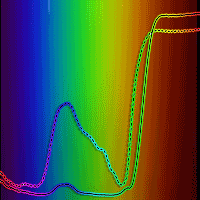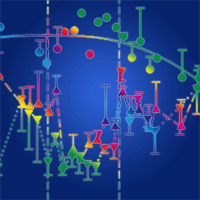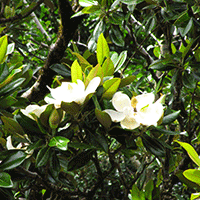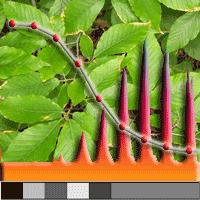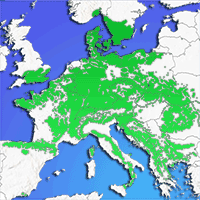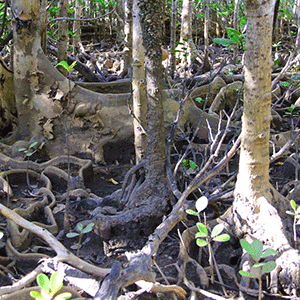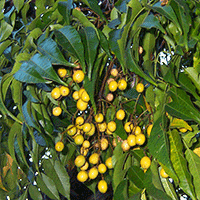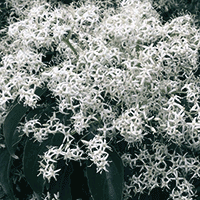Subtropical and tropical species in high altitude suffer from low temperature more frequently than those from temperate regions. Chlorophyll fluorescence analysis can measure the primary photochemical processes of photosystem II (PSII) and help evaluate the sensitivity of evergreen woody plants to low temperature. Coupled with leaf physiognomy, it has allowed to examine the potential thermal regulation of evergreens in response to extreme coldness. The leaf physiognomy (length, width, thickness and ratio of length/width) and chlorophyll a fluorescence (Fv/Fm, maximum potential photochemical efficiency of PSII; NPQ, non-photochemical quenching of chlorophyll fluorescence; and Y(II), effective photochemical quantum yield of photosystem II) under natural freezing and recovery conditions of nine evergreen woody trees were measured to analyze their relationships. Results showed that the changes of Fv/Fm under freezing versus recovery had a positive relationship with leaf length and width, while a negative relationship with leaf thickness. Similar to leaf size, leaf shape also influenced the photoinhibition levels of evergreens by regulating the leaf boundary layer thickness. Leaves with an oval-like shape suffered less from freezing than leaves with a lanceolate-like shape. A relatively weaker relationship between NPQ and Y(II) was found at freezing than after recovery for species with larger and lanceolate-like leaves. Our findings are helpful to understand the adaptation strategy of evergreen woody species to extreme low temperature in subtropical areas and to provide guidance for the management of evergreen plants introduced in botanical gardens.
Keywords
, , , , ,
Citation
Cheng D, Zhang Z, Zhou S, Peng Y, Zhang L (2019). Relationships between leaf physiognomy and sensitivity of photosynthetic processes to freezing for subtropical evergreen woody plants. iForest 12: 551-557. - doi: 10.3832/ifor3196-012
Academic Editor
Claudia Cocozza
Paper history
Received: Jul 19, 2019
Accepted: Oct 14, 2019
First online: Dec 17, 2019
Publication Date: Dec 31, 2019
Publication Time: 2.13 months
© SISEF - The Italian Society of Silviculture and Forest Ecology 2019
Open Access
This article is distributed under the terms of the Creative Commons Attribution-Non Commercial 4.0 International (https://creativecommons.org/licenses/by-nc/4.0/), which permits unrestricted use, distribution, and reproduction in any medium, provided you give appropriate credit to the original author(s) and the source, provide a link to the Creative Commons license, and indicate if changes were made.

Breakdown by View Type
(Waiting for server response...)
Article Usage
Total Article Views: 43049
(from publication date up to now)
Breakdown by View Type
HTML Page Views: 36723
Abstract Page Views: 3504
PDF Downloads: 2068
Citation/Reference Downloads: 12
XML Downloads: 742
Web Metrics
Days since publication: 2196
Overall contacts: 43049
Avg. contacts per week: 137.22
Article Citations
Article citations are based on data periodically collected from the Clarivate Web of Science web site
(last update: Mar 2025)
Total number of cites (since 2019): 1
Average cites per year: 0.14
Publication Metrics
by Dimensions ©
Articles citing this article
List of the papers citing this article based on CrossRef Cited-by.
(1)
Ball MC, Wolfe J, Canny M, Hofmann M, Nicotra AB, Hughes D (2002)Space and time dependence of temperature and freezing in evergreen leaves. Functional Plant Biology 29 (11): 1259-1272.
CrossRef |
Gscholar
(2)
Björkman O, Demmig B (1987)Photon yield of O2 evolution and chlorophyll fluorescence characteristics at 77 K among vascular plants of diverse origins. Planta 170 (4): 489-504.
CrossRef |
Gscholar
(3)
DeEll JR, Toivonen PMA (2003)Practical applications of chlorophyll fluorescence in plant biology. Kluwer Academic Publishers, Dordrecht, Netherlands, pp. 132.
Gscholar
(4)
Demmig-Adams B (1990)Carotenoids and photoprotection in plants: a role for the xanthophyll zeaxanthin. Biochimica et Biophysica Acta (BBA) - Bioenergetics 1020 (1): 1-24.
CrossRef |
Gscholar
(5)
Fang J, Wang Z, Tang Z (2011)Atlas of woody plants in China: distribution and climate. Springer, Berlin, Heidelberg, Germany, pp. 326-1487.
Online |
Gscholar
(6)
Franklin S, Comer P, Evens J, Ezcurra E, Faber-Langendoen D, Franklin J, Jennings M, Josse C, Lea C, Loucks O, Muldavin E, Peet R, Ponomarenko S, Roberts D, Solomeshch A, Keeler-Wolf T, Kley JV, Weakley A, McKerrow A, Burke M, Spurrier C (2015)How a national vegetation classification can help ecological research and management. Frontiers in Ecology and the Environment 13 (4): 185-186.
CrossRef |
Gscholar
(7)
Ge JL, Xie ZQ (2017)Geographical and climatic gradients of evergreen versus deciduous broad-leaved tree species in subtropical China: implications for the definition of the mixed forest. Ecology and Evolution 7 (11): 3636-3644.
CrossRef |
Gscholar
(8)
Givnish TJ (2002)Adaptive significance of evergreen
vs. deciduous leaves: solving the triple paradox. Silva Fennica 36 (3): 703-743.
CrossRef |
Gscholar
(9)
Gottschlich DE, Smith AP (1982)Convective heat transfer characteristics of toothed leaves. Oecologia 53 (3): 418-420.
CrossRef |
Gscholar
(10)
Grace J, Fasehun FE, Dixon M (1980)Boundary layer conductance of the leaves of some tropical timber trees. Plant, Cell and Environment 3 (6): 443-450.
CrossRef |
Gscholar
(11)
Grubb PJ (1977)Control of forest growth and distribution on wet tropical mountains: with special reference to mineral nutrition. Annual Review of Ecology and Systematics 8 (1): 83-107.
CrossRef |
Gscholar
(12)
Harrison SP, Prentice IC, Barboni D, Kohfeld KE, Ni J, Sutra JP (2010)Ecophysiological and bioclimatic foundations for a global plant functional classification. Journal of Vegetation Science 21 (2): 300-317.
CrossRef |
Gscholar
(13)
Holmes MG, Keiller DR (2002)Effects of pubescence and waxes on the reflectance of leaves in the ultraviolet and photosynthetic wavebands: a comparison of a range of species. Plant, Cell and Environment 25 (1): 85-93.
CrossRef |
Gscholar
(14)
Kincaid DT (1976)Theoretical and experimental investigations of
Ilex pollen and leaves in relation to microhabitat in the southeastern United States. PhD thesis, Wake Forest University, Winston-Salem, NC, USA, pp. 336.
Gscholar
(15)
Leegood RC, Edwards GE (1996)Carbon metabolism and photorespiration: temperature dependence in relation to other environmental factors. In: “Photosynthesis and the Environment” (Baker NR ed). Springer, Dordrecht, Netherlands, pp. 191-221.
CrossRef |
Gscholar
(16)
Leigh A, Sevanto S, Ball MC, Close JD, Ellsworth DS, Knight CA, Nicotra AB, Vogel S (2012)Do thick leaves avoid thermal damage in critically low wind speeds? New Phytologist 194 (2): 477-487.
CrossRef |
Gscholar
(17)
Leigh A, Sevanto S, Close JD, Nicotra AB (2017)The influence of leaf size and shape on leaf thermal dynamics: does theory hold up under natural conditions? Plant, Cell and Environment 40 (2): 237-248.
CrossRef |
Gscholar
(18)
Leuning R (1988)Leaf temperatures during radiation frost Part II. A steady state theory. Agricultural and Forest Meteorology 42 (2): 135-155.
CrossRef |
Gscholar
(19)
Li ZZ, Li XM, Rubert-Nason KF, Yang Q, Fu Q, Feng JC, Shi S (2018)Photosynthetic acclimation of an evergreen broadleaved shrub (
Ammopiptanthus mongolicus) to seasonal climate extremes on the Alxa Plateau, a cold desert ecosystem. Trees 32 (2): 603-614.
CrossRef |
Gscholar
(20)
Lusk CH, Clearwater MJ, Laughlin DC, Harrison SP, Prentice IC, Nordenstahl M, Smith B (2018)Frost and leaf-size gradients in forests: global patterns and experimental evidence. New Phytologist 219 (2): 565-573.
CrossRef |
Gscholar
(21)
Meng TT, Wang H, Harrison SP, Prentice IC, Ni J, Wang G (2015)Responses of leaf traits to climatic gradients: adaptive variation
versus compositional shifts. Biogeosciences 12 (9): 5339-5352.
CrossRef |
Gscholar
(22)
Müller P, Li XP, Niyogi KK (2001)Non-photochemical quenching. A response to excess light energy. Plant Physiology 125(4): 1558.
CrossRef |
Gscholar
(23)
Nichlos SA, Wilson CR, Lusk CH (2019)Differential effects of elevation on leaf size of overstorey and understorey species in a temperate rainforest. New Zealand Journal of Botany 57 (1): 39-49.
CrossRef |
Gscholar
(24)
Nicotra AB, Cosgrove MJ, Cowling A, Schlichting CD, Jones CS (2008)Leaf shape linked to photosynthetic rates and temperature optima in South African
Pelargonium species. Oecologia 154 (4): 625-635.
CrossRef |
Gscholar
(25)
Niinemets U (1999)Research review. Components of leaf dry mass per area- thickness and density-alter leaf photosynthetic capacity in reverse directions in woody plants. New Phytologist 144 (1): 35-47.
CrossRef |
Gscholar
(26)
Niinemets U (2001)Global-scale climatic controls of leaf dry mass per area, density, and thickness in trees and shrubs. Ecology 82 (2): 453-469.
CrossRef |
Gscholar
(27)
Nobel PS (1975)Effective thickness and resistance of the air boundary layer adjacent to spherical plant parts. Journal of Experimental Botany 26 (1): 120-130.
CrossRef |
Gscholar
(28)
Öquist G, Hüner NP (2003)Photosynthesis of overwintering evergreen plants. Annual Review of Plant Biology 54: 329-355.
CrossRef |
Gscholar
(29)
Parkhurst DF, Loucks O (1972)Optimal leaf size in relation to environment. Journal of Ecology 60 (2): 505-537.
CrossRef |
Gscholar
(30)
Peppe DJ, Royer DL, Cariglino B, Oliver SY, Newman S, Leight E, Enikolopov G, Fernandez-Burgos M, Herrera F, Adams JM (2011)Sensitivity of leaf size and shape to climate: global patterns and paleoclimatic applications. New Phytologist 190 (3): 724-739.
CrossRef |
Gscholar
(31)
Richards PW, Ashton PS (1997)The tropical rain forest (2nd edn). Trends in Ecology and Evolution 12 (5): 202-202.
CrossRef |
Gscholar
(32)
Royer DL, Wilf P, Janesko DA, Kowalski EA, Dilcher DL (2005)Correlations of climate and plant ecology to leaf size and shape: potential proxies for the fossil record. American Journal of Botany 92 (7): 1141-1151.
CrossRef |
Gscholar
(33)
Serôdio J, Vieira S, Cruz S, Coelho H (2006)Rapid light-response curves of chlorophyll fluorescence in microalgae: relationship to steady-state light curves and non-photochemical quenching in benthic diatom-dominated assemblages. Photosynthesis Research 90 (1): 29-43.
CrossRef |
Gscholar
(34)
Sharma P, Sharma N, Deswal R (2005)The molecular biology of the low temperature response in plants. Bioessays 27 (10): 1048-1059.
CrossRef |
Gscholar
(35)
Tang CQ, Ohsawa M (1997)Zonal transition of evergreen, deciduous, and coniferous forests along the altitudinal gradient on a humid subtropical mountain, Mt. Emei, Sichuan, China. Plant Ecology 133 (1): 63-78.
CrossRef |
Gscholar
(36)
Tang CQ, Ohsawa M (1999)Altitudinal distribution of evergreen broad-leaved trees and their leaf-size pattern on a humid subtropical mountain, Mt. Emei, Sichuan, China. Plant Ecology 145 (2): 221-233.
CrossRef |
Gscholar
(37)
Vogel S (2009)Leaves in the lowest and highest winds: temperature, force and shape. New Phytologist 183 (1): 13-26.
CrossRef |
Gscholar
(38)
Wang H, Prentice I, Ni J (2013)Data-based modelling and environmental sensitivity of vegetation in China. Biogeosciences 10 (9): 5817-5830.
CrossRef |
Gscholar
(39)
Whitmore TC (1975)Tropical rain forests of the Far East. Clarendon Press, Oxford, UK, pp. 282.
Online |
Gscholar
(40)
Wright IJ, Dong N, Maire V, Prentice IC, Westoby M, Díaz S, Gallagher RV, Jacobs BF, Kooyman R, Law EA, Leishman MR, Niinemets Ü, Reich PB, Sack L, Villar R, Wang H, Wilf P (2017)Global climatic drivers of leaf size. Science 357(6354): 917-921.
CrossRef |
Gscholar
(41)
Yang J, Spicer RA, Spicer TEV, Arens NC, Jacques FMB, Su T, Kennedy EM, Herman AB, Steart DC, Srivastava G, Mehrotra RC, Valdes PJ, Mehrotra NC, Zhou ZK, Lai JS (2015)Leaf form-climate relationships on the global stage: an ensemble of characters. Global Ecology and Biogeography 24 (10): 1113-1125.
CrossRef |
Gscholar
(42)
Zhang XS (2007)Vegetation map of the People’s Republic of China (1:1.000.000). Geological Publishing House, Beijing, China, pp. 93.
Gscholar


